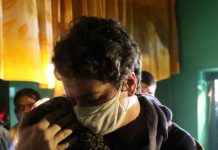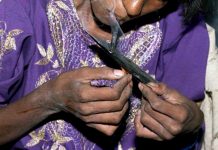 Health camps organised in Chhattisgarh’s rural markets, popularly known as haat-bazaars, are changing the healthcare delivery system in remote and inaccessible areas. Stalls offering blood pressure, malaria and sugar tests are a common sight in these colourful, noisy places where people gather in large numbers for weekly marketing and social interaction.
Health camps organised in Chhattisgarh’s rural markets, popularly known as haat-bazaars, are changing the healthcare delivery system in remote and inaccessible areas. Stalls offering blood pressure, malaria and sugar tests are a common sight in these colourful, noisy places where people gather in large numbers for weekly marketing and social interaction.
“As a majority of people can be reached in these areas, organising heath camps is a good move,” said Bhupesh Tiwari of Sathi Samaj Sevi Sanstha, a non-profit based in Kondagaon district of the state, and working in the areas of health and malnutrition.
A novel concept
For organising haat bazaar health camps, Unicef entered into a partnership with the Ramakrishna Mission in 2011 and with Sathi in 2012. Over the years, these camps have gained immense popularity for targeting the vulnerable tribal population, especially in the Bastar area marked by Leftwing extremism. According to Vishal Vasvani, emergency officer at Unicef, the haat bazaar health day concept was a direct follow-up of the haat bazaar immunisation campaign, which was already going on to cover dropouts.
Tiwari added that in remote tribal areas, access to basic health services often remains poor. Many children are also left out of the immunisation coverage as their mothers take them along for work.
Pramod Potai, who works for Sathi, said, “As initially the immunisation rate was low, we had to somehow ensure total coverage. In the field, we faced a lot of hardships and many children were left out. To remove obstacles in our way, the haat bazaar immunisation day was conceptualised.” It made things easy. As tribals visit weekly markets for buying and selling purposes, along with their children, we could cover the dropouts, he added.
Tiwari explained that keeping in mind the issue of exclusion, haat bazaar health camps were launched and the immunisation coverage reached 92 per cent. Gradually, OPD services were also started at these camps with the help of Unicef funding. “Now, for one haat bazaar, we receive about 1,500 with kits. We are doing it at five places in Narayanpur block of Narayanpur district covering about 20 villages,” he added.
Sathi counsellor Nisha Nishad pointed out that as OPD services are not up to the standard in tribal-dominated areas, people demand quality check-ups, medicines and treatment. So, when the health camps started, the response was overwhelming.
Ajay Baidh, another Sathi worker, informed that usually big bazaars are chosen for more outreach. For attracting people to the camps, announcements about services offered are made through sound systems in Hindi as well as local dialects. “Initially, people used to attend as it was a novel concept. But now patients regularly come from even far-flung villages, he said. The camps are set up by 11 am and continue till 5 pm. In each camp, there are volunteers, counsellors and supervisors to help patients.
Data shared by Unicef says that from 2014 till now, Sathi has targeted 6,907 beneficiaries through these haat bazaar health camps.
As part of the partnership with both the Ramakrishna Mission as well as Sathi, Unicef has organised 1,433 haat bazaars from 2012 till now at a total budget of 39,61,800. The total number of beneficiaries stands at 23,259, which consists of mainly women and children. “Behavioural change takes lot of time. But now people come to us of their own,” Tiwari said.
The government initiative
The Chhattisgarh government led by Chief Minister Bhupesh Baghel is also doing its bit to ensure that quality health services reach the vulnerable tribal population.
In this regard, the Mukhyamantri Haat Bazaar Clinic Yojana was rolled out from October 2, 2019. “It is a government initiative aimed at targeting tribal areas where health facilities are often absent. Many a times, tribals lack the means to visit doctors or opt for quality health facilities,” said Taran Sinha, commissioner, public relations.
Initially started from Bastar, the initiative now covers the entire state. Till March 2020, about 26,357 haat bazaar clinics have been organised and over 91 lakh people have been covered. Some 8 lakh patients have derived benefits from these camps.
About 44 per cent of Chhattisgarh is under forest cover and 31 per cent of the state’s population comprises tribals with high malnutrition rate. Auxiliary nurse midwife Neelmani Dutta of Edka (a village in Narayanpur) sub-health centre said that the issue of malnutrition is serious due to the lack of awareness in tribal-dominated areas.
Tiwari added that the absence of dietary diversity is often responsible for the scenario. Often pregnant women are malnourished and anaemic, and thus, give birth to low-weight babies. To arrest the problem of malnutrition, Sathi is also working on popularising the concept of kitchen gardens in its intervention areas.
letters@tehelka.com













